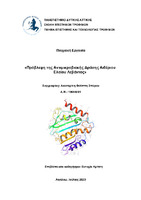| dc.contributor.advisor | Κρίτση, Ευτυχία | |
| dc.contributor.author | Σπύρου, Αικατερίνη Φιλίππη | |
| dc.date.accessioned | 2023-07-27T09:30:33Z | |
| dc.date.available | 2023-07-27T09:30:33Z | |
| dc.date.issued | 2023-07-14 | |
| dc.identifier.uri | https://polynoe.lib.uniwa.gr/xmlui/handle/11400/4880 | |
| dc.identifier.uri | http://dx.doi.org/10.26265/polynoe-4718 | |
| dc.description | pathogenic bacteria, foodborne diseases, lavender essential oil, dihydrofolate reductase, DNA gyrase B, virtual screening techniques, molecular docking | el |
| dc.description.abstract | Σήμερα, κρίσιμο πρόβλημα για τη βιομηχανία τροφίμων συνιστά η ανάπτυξη αλλά και ο πολλαπλασιασμός των παθογόνων μικροοργανισμών στα προϊόντα τροφίμων. Αποτέλεσμα αποτελεί η πιθανή μόλυνση του ανθρώπου από την κατανάλωσή τους με κίνδυνο την απαιτούμενη ασφάλεια και ποιότητα των προϊόντων. Τροφιμογενείς ασθένειες με σοβαρές επιπτώσεις στην υγεία αναπτύσσονται εξαιτίας βακτηρίων όπως, Staphylococcus spp. και Escherichia coli. Επομένως, η αντιμετώπισή τους κρίνεται απαραίτητη. Η πρόληψη είναι δυνατή μέσω εφαρμογής κατάλληλων πρακτικών υγιεινής, ενώ ορισμένοι τρόποι αντιμετώπισης σχετίζονται με τη θερμική επεξεργασία και τη χρήση αντιβιοτικών. Λόγω της υποβάθμισης των οργανοληπτικών χαρακτηριστικών και την αντοχή στα αντιβιοτικά που αναπτύσσουν οι μικροοργανισμοί, δημιουργούνται νέες τάσεις για την καταπολέμηση τους. Τα τελευταία χρόνια σημειώνονται αξιόλογες προσπάθειες προς εύρεση νέων, κυρίως φυσικών, ενώσεων με αντιμικροβιακή δράση που προστίθενται στα προϊόντα τροφίμων.
Σκοπός της εν λόγω πτυχιακής εργασίας είναι η πρόβλεψη της αντιμικροβιακής δράσης των ενώσεων που περιέχονται στο αιθέριο έλαιο λεβάντας κατά της δράσης των ενζύμων διϋδροφολικής αναγωγάσης και DNA γυράσης B των παθογόνων βακτηρίων, S.aureus και E.coli, μέσω εφαρμογής υπολογιστικών εργαλείων εικονικής σάρωσης.
Η αξιολόγηση των αποτελεσμάτων και η τελική επιλογή των ενώσεων βασίστηκε στα ακόλουθα κριτήρια:
σχηματισμός αλληλεπιδράσεων μεταξύ των εξεταζόμενων ενώσεων και αμινοξέων που περιλαμβάνονται στη θέση πρόσδεσης και ικανότητα πρόσδεσης των εξεταζόμενων φυσικών ενώσεων (Glide-score).
Τέλος, από την αξιολόγηση των αποτελεσμάτων της μοριακής πρόσδεσης (molecular docking) προέκυψαν τρεις ενώσεις, οι οποίες δύναται να αγοραστούν μελλοντικά και να πραγματοποιηθεί in vitro βιολογική τους αποτίμηση ως αναστολείς του ενζύμου DNA γυράση B του S.aureus. | el |
| dc.format.extent | 115 | el |
| dc.language.iso | el | el |
| dc.publisher | Πανεπιστήμιο Δυτικής Αττικής | el |
| dc.rights | Αναφορά Δημιουργού - Μη Εμπορική Χρήση - Παρόμοια Διανομή 4.0 Διεθνές | * |
| dc.rights | Attribution-NoDerivatives 4.0 Διεθνές | * |
| dc.rights.uri | http://creativecommons.org/licenses/by-nd/4.0/ | * |
| dc.subject | Παθογόνα βακτήρια | el |
| dc.subject | Τροφιμογενή νοσήματα | el |
| dc.subject | Αιθέριο έλαιο λεβάντας | el |
| dc.subject | Διϋδροφολική αναγωγάση | el |
| dc.subject | DNA γυράση , | el |
| dc.subject | Τεχνικές εικονικής σάρωσης | el |
| dc.subject | Μοριακή πρόσδεση | el |
| dc.subject | Λεβάντα | el |
| dc.title | Πρόβλεψη της αντιμικροβιακής δράσης αιθέριου ελαίου λεβάντας | el |
| dc.title.alternative | Antimicrobial activity prediction of lavender essential oil | el |
| dc.type | Πτυχιακή εργασία | el |
| dc.contributor.committee | Σινάνογλου, Βασιλεία | |
| dc.contributor.committee | Zoumpoulakis, Panagiotis | |
| dc.contributor.faculty | Σχολή Επιστημών Τροφίμων | el |
| dc.contributor.department | Τμήμα Επιστήμης και Τεχνολογίας Τροφίμων | el |
| dc.description.abstracttranslated | Nowadays, the growth and multiplication of pathogenic microorganisms in food products is consider an important issue for the food industry in terms of safety and quality of the final product and human health. Bacteria, such as Staphylococcus spp. and Escherichia coli are responsible for foodborne illnesses causing serious health-related problems. In order to reduce and prevent the risk of foodborne illnesses, appropriate hygiene policies should be implemented, whereas food processing practices and the use of antibiotics enable their treatment. Τhe degradation of foods organoleptic characteristics and the resistance to antibiotics have create new trends for microorganisms confrontation. During these past few years, notable efforts have been made, in order to discover novel, mainly natural compounds that act as antibacterial agents when added to food products.
The aim of the present thesis is the application of virtual screening techniques to predict the inhibitory activity of compounds present in lavender essential oil.
Particularly, dihydrofolate reductase and DNA gyrase B of S.aureus and E.coli were investigated.
The results assessment and the final compound selection were based on the following criteria:
interactions between the tested compounds and the amino-acids of the binding site and predicted binding affinity of the examined compounds (Glide-score).
Finally, the molecular docking results evaluation indicated three lavender essential oil compounds, which can be purchased and tested through in vitro enzymatic assays to validate their activity as inhibitors of the DNA Gyrase B enzyme of S.aureus. | el |


